When I first learned about Hawaiian wood carving, I was amazed by how deeply it connects to the history and culture of the islands.

Skilled artists in Hawaii started wood carving long before modern times. They crafted important objects like canoes, statues, and tools that played big roles in daily life and spiritual belief.
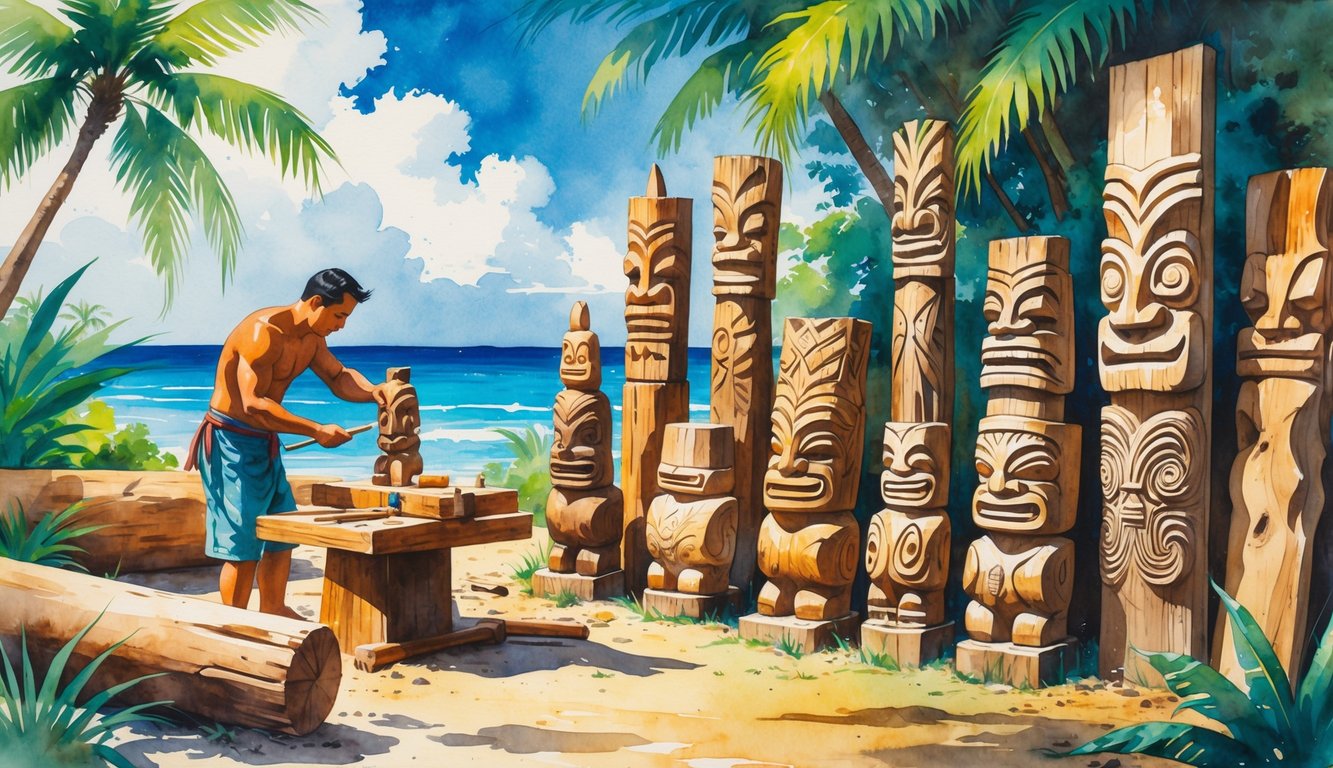
These carvings were not just art. Each piece carried special meaning and told its own story.
Priest-carvers, called kāhuna kālai ki‘i, often made statues known as ki‘i to represent gods or ancestors. They used skills handed down over generations.
Today, artists in Hawaii work to keep these traditions alive. They also add their own modern touches.
Origins of Hawaiian Wood Carving

Hawaiian wood carving developed over centuries of skill and cultural blending. Its roots are in Polynesian migration and artistry.
The unique characteristics of Hawaiian carving reflect a mix of history, environment, and creative tradition.
Polynesian Roots
The history of wood carving in Hawaii goes back to early Polynesia. Polynesians came from places like Samoa, Tahiti, and the Marquesas, where wood carving was already respected.
These expert navigators brought their carving tools and cultural knowledge on long ocean voyages. They used wood to create canoes, household items, weapons, and religious figures.
Polynesians made figures called “tiki” to show respect to deities and ancestors. Each piece showed detailed craftsmanship and meaning.
These traditions later shaped the carving styles found in Hawaii. They helped form the base for a uniquely Hawaiian art.
Migration to the Hawaiian Islands
Polynesians settled the Hawaiian Islands around 1,500 years ago and brought their carving traditions with them. The islands offered new types of native wood, like koa and milo, which became central materials in Hawaiian art.
Migration changed everything for these early settlers. New trees and plants meant Polynesians learned to shape and use unfamiliar materials.
They merged old carving techniques with what they found in Hawaii’s forests. Hawaiian carvers soon focused on everyday objects like bowls, utensils, and surfboards.
They also continued spiritual work by carving idols, drums, and mask-like images. This period blended practical needs with spiritual expression.
Influence of Polynesian Artistry
Polynesian artistry still appears in almost every part of Hawaiian wood carving. Many designs use curving lines, geometric shapes, and themes from nature, such as waves, birds, and plants.
Polynesians valued symmetry and repetition, which remain clear in Hawaiian carvings today. Items like ki’i (statues) and ceremonial paddles show design features from other Polynesian cultures.
The respect for craftsmanship and spiritual power, or “mana,” continues through generations. Master carvers now add their own creative touches while working within a tradition defined by Polynesian origins.
The skills brought by the first Pacific navigators live on through every carved piece. Artists today keep these traditions alive.
Materials Used in Hawaiian Wood Carving
Hawaiian wood carving relies on the types of wood found on the islands. The choice of wood affects the shape and meaning of each piece.
Different trees offer unique grains, colors, and spiritual significance.
Significance of Koa Wood
Koa wood is one of the most prized materials in traditional Hawaiian carving. The koa tree grows only in Hawaii, making its wood rare and special.
Its deep, rich color and beautiful grain patterns give every finished piece a distinct look. Koa is strong but easy to work with, making it ideal for weapons, canoes, and decorative items.
Many important objects like bowls, surfboards, and musical instruments have been carved from koa for centuries. For Hawaiians, koa is a symbol of strength, pride, and connection to the land.
The Hawaiian koa tree remains a favorite choice for carvers today.
Use of Mango and Monkeypod
Craftsmen also use mango wood and monkeypod for carving. Mango wood comes from the fruit tree and is loved for its light brown color and streaks of yellow or pink.
It is softer than koa, which makes it easier to carve into bowls, trays, and small statues. Monkeypod, also known as rain tree or saman, has a wide canopy and broad trunk.
Its wood features a golden-brown hue with dark, swirling grains. Monkeypod is durable and resists cracking, so it’s great for large serving bowls, furniture, and decorative tikis.
Both mango and monkeypod offer beautiful alternatives when koa is too costly or scarce.
Other Native Woods
Other native woods in Hawaii also play important roles in carving. The kou tree was often chosen for making food containers because it doesn’t affect taste.
Old Hawaiian families prized kou bowls for serving food. Milo wood offers a reddish tone and was used for storage containers and decorative pieces.
Carvers have also used woods like ohi‘a-lehua and kauila, which are harder but valued for their deep color and strength. Each native wood has its own special role.
Their different textures and appearances provide a wide range for creative carving projects.
Traditional Tools and Techniques
Hawaiian wood carving uses specific tools, learned skills, and careful attention to patterns. Each part of the process is crucial for carrying on this ancient tradition with respect.
Ancestral Carving Tools
Early Hawaiians made their tools from local materials. One main tool was the adze, which had a sharp edge made from basalt or coral and was attached to a wooden handle.
The adze shaped and smoothed the wood. Carvers also used wooden mallets, chisels, and gouges.
These chisels came in different shapes and sizes for cutting both deep and shallow lines. Bones and shark teeth sometimes made useful cutting edges for small, delicate work.
Today, some carvers still use traditional tools, while others use metal blades and modern carving sets. These tools remain key for Hawaiian woodworking.
You can learn more about these traditional implements from the list of tools commonly used in Hawaiian wood carving.
Carving Techniques and Methods
Patience and precision matter most in Hawaiian carving techniques. Traditional carvers often started with a rough outline, then slowly removed wood in thin shavings.
Careful, repeated strokes ensured accuracy and protected the wood from splitting. Some techniques, like chip carving, used chiseling out repeated patterns to create texture.
Working with the wood grain helped avoid breakage and brought out the wood’s beauty. Many carvers use an apprenticeship system, learning hands-on with a master.
Workshops and formal classes now also teach these traditional skills to new generations. You can explore more about learning Hawaiian carving techniques today.
Intricate Details in Design Work
Details make Hawaiian wood carvings stand out. Artists use chisels and gouges of different sizes for deep grooves, fine lines, or swirling curves.
The goal is to capture specific symbols, spiritual beliefs, or family stories within the wood. Patterns such as zigzags, spirals, and geometric shapes are often repeated.
Each mark tells its own story. The most detailed work often appears on ceremonial objects, such as gods (ki’i), bowls, or decorative paddles.
Adding these intricate details takes skill, steady hands, and sharp tools. Every small cut and curve gives the craft its life and meaning.
If you want to see how modern artists combine tradition with creativity, you can read about the contemporary scene of Hawaiian wood carving.
Iconic Forms and Functions
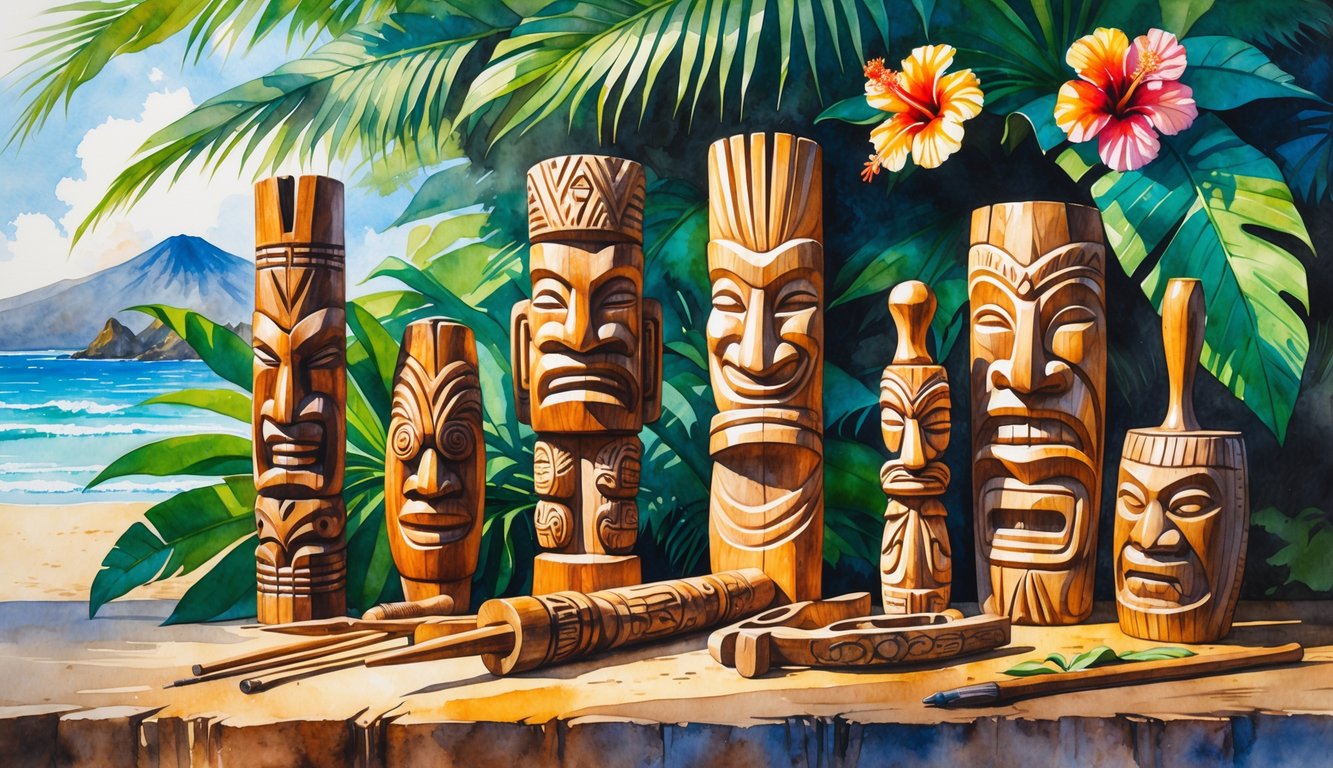
Wood carving in Hawaii shows deep respect for history, beliefs, and daily life. Skills and symbols pass down over generations, with each carved object having a clear purpose and story.
Ki’i and Akua Figures
Carvers create ki’i, which are wooden images representing deities known as akua. Each figure honors gods or cherished ancestors.
People place these figures in heiau (temples) or important sites for worship and protection. Ki’i are not just art.
They act as guardians and hold the mana, or spiritual power, within a community. Only skilled carvers, sometimes priests called kāhuna kālai ki’i, take on this special task.
The design of each figure is unique and meaningful, reflecting the specific deity or ancestor. These carvings link people to their gods and the ali’i, or chiefs, who are believed to hold divine power.
Careful details, faces, and postures show the character and role of each akua. Learn more about how ki’i were connected to Hawaiian religion and society.
Tiki Statues and Tiki Carvings
Many people think of tiki statues first when they picture Hawaiian wood carving. Each tiki has a unique look, with bold faces, deep eyes, and strong expressions.
No two tiki are alike. Every tiki carving stands for something different, like protection, strength, or luck.
These statues play a key role in both ancient and modern Hawaiian culture. They show pride in ancestral ties.
You can find them at cultural sites, in gardens, and even at businesses today. Carvers focus on the faces because they tell a story or share an emotion.
People see them as works of art, but their use goes beyond decoration. Many treat them as spiritual guides.
Read more about the tradition and unique features of tiki carvings.
Canoes and Outrigger Canoes
Canoes, especially outrigger canoes, are some of the most important Hawaiian wood carvings. The skills needed to make them were vital for travel, fishing, and trade.
Carvers shaped each canoe from a single log, usually koa wood, working together as a team. The outrigger on one side made the canoes steady and safe for ocean trips.
This clever design shows how carvers worked closely with nature. Building a canoe involved special prayers and rituals to ask for guidance from the akua.
These boats helped the first Polynesian voyagers settle Hawaii. Chiefs, or ali’i, used them to travel between islands.
Canoe carving remains an honored craft.
Umeke, Ukulele, and Feather Work
Umeke are carved wooden bowls used for storing and serving food. They blend usefulness and beauty, often with smooth finishes and elegant shapes.
The ukulele, shaped first by Portuguese immigrants, uses native woods and Hawaiian carving styles. It quickly became a symbol of music and happiness across Hawaii.
Feather work often combined with carved wooden bases, especially for royal capes and helmets. These items were treasured by the ali’i, showing rank and power.
Contemporary Hawaiian featherwork often features rare koa wood and detailed designs.
Role in Hawaiian Culture and Heritage
Wood carving is more than just art for me. It connects me with my ancestors, my community, and the stories that shape who I am.
Each piece I carve holds meaning. It teaches me traditions and strengthens my identity.
Cultural and Spiritual Significance
When I carve wood in the Hawaiian style, I practice an art deeply woven into my culture and beliefs. Many objects I make—like ki‘i (tiki figures) and statues—carry spiritual meanings.
Some carvings hold mana, the spiritual energy of a person or god. I treat these objects with respect and sometimes use them in rituals or as guardians of sacred spaces.
They serve as a bridge between the physical world and the spiritual realm. These carvings remind me of my ancestors’ values and traditions.
Wood carving is closely tied to storytelling. Every cut continues ancient legends and honors the spirits important to Hawaiian life.
Carving helps me keep these beliefs alive and relevant.
Expression of Cultural Identity
Wood carving is one of the most visible symbols of my cultural identity. It lets me express both personal creativity and a shared heritage with other Hawaiians.
Designs and patterns on each carving tell stories of my home, from waves and animals to shapes found in nature. Carving helps me learn and pass on Hawai‘i’s history.
For example, tiki figures carved into wood often represent ancestors or spirits. These carvings teach younger generations about their roots.
By practicing and teaching these techniques, I help ensure the traditions continue. Many artists blend old methods with new ideas, keeping the tradition alive while adapting to modern times.
This blend gives me pride in my heritage and shows how Hawaiian culture keeps growing.
Connection to Hawaiian Royalty
Wood carving played an important role in the lives of Hawaiian royalty. Chiefs and kings used finely carved objects as symbols of their status and power.
Skilled carvers made royal staffs, thrones, and ceremonial items for the aliʻi (chiefs) and royal family. Some of these carvings held sacred meanings, while others showed political rank.
Feathered and carved items, when used together, marked a chief’s high standing in the community. Museums and cultural centers still display many of these artifacts as part of Hawaii’s rich heritage.
By learning about the special relationship between wood carving and royalty, I see how this traditional Hawaiian art is about more than beauty. It also represents leadership, heritage, and respect for cultural traditions.
For more about Hawaiian wood carving and its ties to tradition and Hawaiian arts, I enjoy exploring local workshops and collections.
Changes After Western Contact
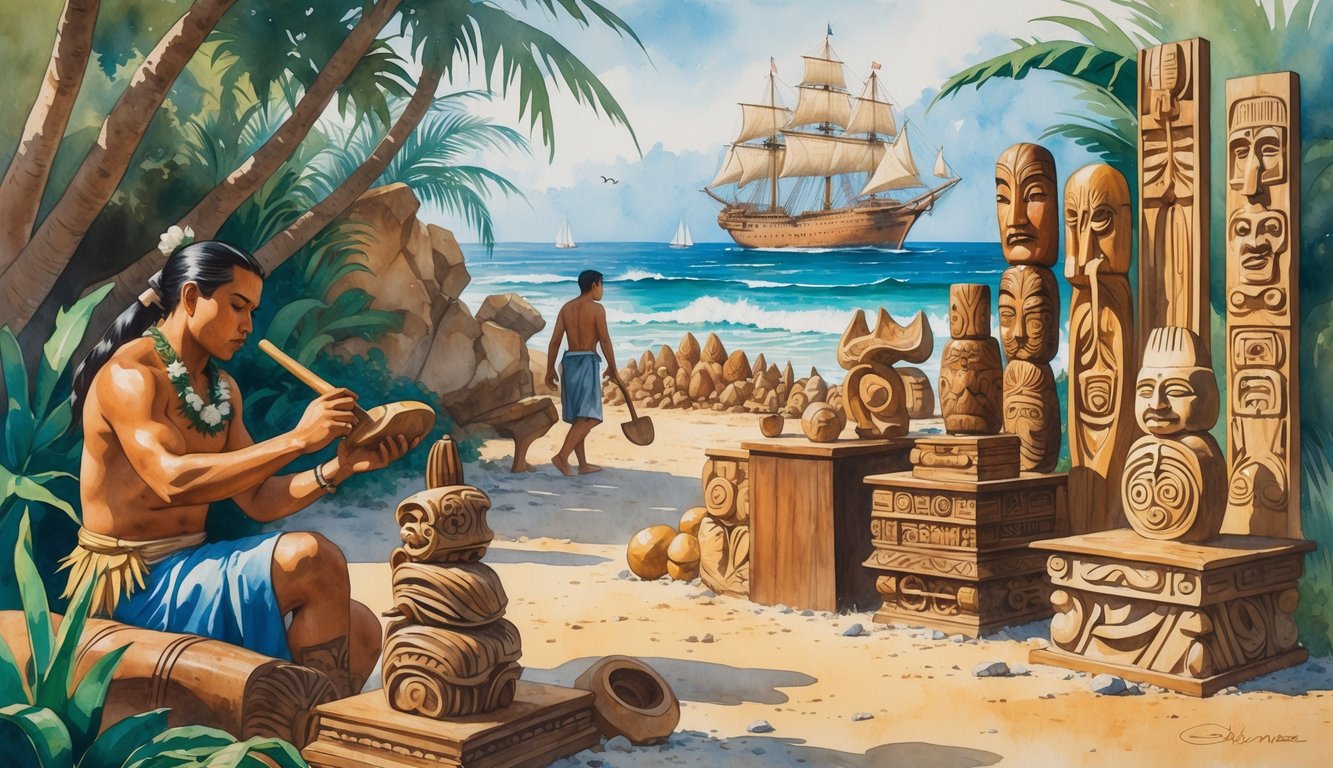
Western influence brought big changes to Hawaiian wood carving. New tools and different objects appeared after Westerners arrived, especially on the Big Island of Hawaii.
Arrival of Captain Cook and Westerners
When Captain Cook landed in Hawai‘i in 1778, everything started to change. I imagine seeing new faces and unfamiliar ships arrive near the coast.
As more Westerners came, they brought metal tools. These tools looked very different from the stone, bone, or shell tools I used before.
Western visitors also brought new beliefs. Some of my carvings seemed old-fashioned or even dangerous to them.
I had to think about how my art could survive in a fast-changing world. Many traditional gatherings and religious practices that inspired my work were discouraged or banned by new leaders and missionaries.
Artists had to get creative to keep our traditions alive.
Impact on Techniques and Materials
Before Western ships arrived, I carved using tools made from animal bones, stone, or coral. These tools worked slowly, but I understood every mark I made.
Metal blades and saws brought by Westerners changed my process. I could carve faster, create finer details, and try new shapes.
The kinds of wood I used changed too. While koa and ʻōhiʻa were my traditional choices, I saw other types of wood arrive as Western ships brought new materials.
Some new woods were easier to carve, but not all matched the strength or spiritual meaning of Hawaiian woods. The demand for my work also shifted.
Instead of making only ceremonial pieces, I started making art for Western buyers and tourists. This changed how and why I carved.
Preservation of Traditions
Even with many changes, I worked hard to honor my ancestors and keep their ways alive. When Western influences pushed my culture aside, I found new ways to share old stories.
Sometimes I hid sacred carvings or kept their meanings secret, sharing them only with others who understood my culture. Other times, I blended old and new by using metal tools to create traditional patterns in my own style.
Today, people have renewed respect for these traditions. Artists still use traditional methods and materials when possible, even as they adapt to modern life.
Museums and cultural sites on the Big Island of Hawaii and beyond help display and protect wood carvings. This ensures these stories stay alive for future generations.
Contemporary Hawaiian Wood Carving
Today, wood carving in Hawaii mixes old traditions with new tools and creative ideas. Artists use skills passed down through generations and modern innovations.
This blend helps the art continue to grow and inspire.
Modern Tools and Innovations
Carvers in Hawaii often use both traditional tools and updated equipment. Many start with chisels and a wooden mallet.
Now, they also use power tools to shape larger pieces more quickly or with more detail. Modern carving kits can include many chisels in different shapes and sizes.
Some artists, especially professionals, invest in high-quality, fine-steel chisels. At places like the Polynesian Cultural Center, some chisels can cost up to $40 each.
These advanced tools allow for clean cuts and smooth lines. The artwork becomes even more impressive.
Key things in today’s toolkits:
- Electric sanders
- Modern carving knives
- Dremel tools and rotary equipment
- Laser engravers for adding intricate designs
Artists use new finishes and protective coatings to keep the art looking good in Hawaii’s humid climate. This helps carvings stay beautiful for many years.
Notable Artists and Tiki Masters
Modern Hawaiian carvers, especially master carvers called Tiki Masters, show great skill. They train for years to perfect their craft.
Tiki Masters create figures inspired by ancient Hawaiian gods. They blend old styles with their own vision.
Their work appears in public places, galleries, and special events. Some carvers focus on contemporary sculpture and abstract wooden forms.
Artists like Shaun Thomas create large wooden waves and tiki sculptures that reflect the local environment and surf culture. Each piece feels personal, showing respect for tradition and modern creativity.
You can see their works at places like Shaun Thomas’s online gallery.
Integration in Contemporary Art
Hawaiian wood carving now goes far beyond traditional tikis and religious symbols. I see wooden artwork in hotels, museums, and homes as both decoration and a reminder of heritage.
Many carvers try new styles and methods, blending Hawaiian themes with modern ideas. They use unusual woods, mix in other materials like metal or glass, and work with painters or digital artists.
Modern Hawaiian wood carving keeps its roots but welcomes creativity and new forms. Both local residents and visitors appreciate how these works connect the past with the present.
For example, you can see vivid and innovative sculptures on display in places like Maui. These works blend tradition with modern flair—find more at this Hawaii wood sculpture article.
Learning and Preserving the Craft
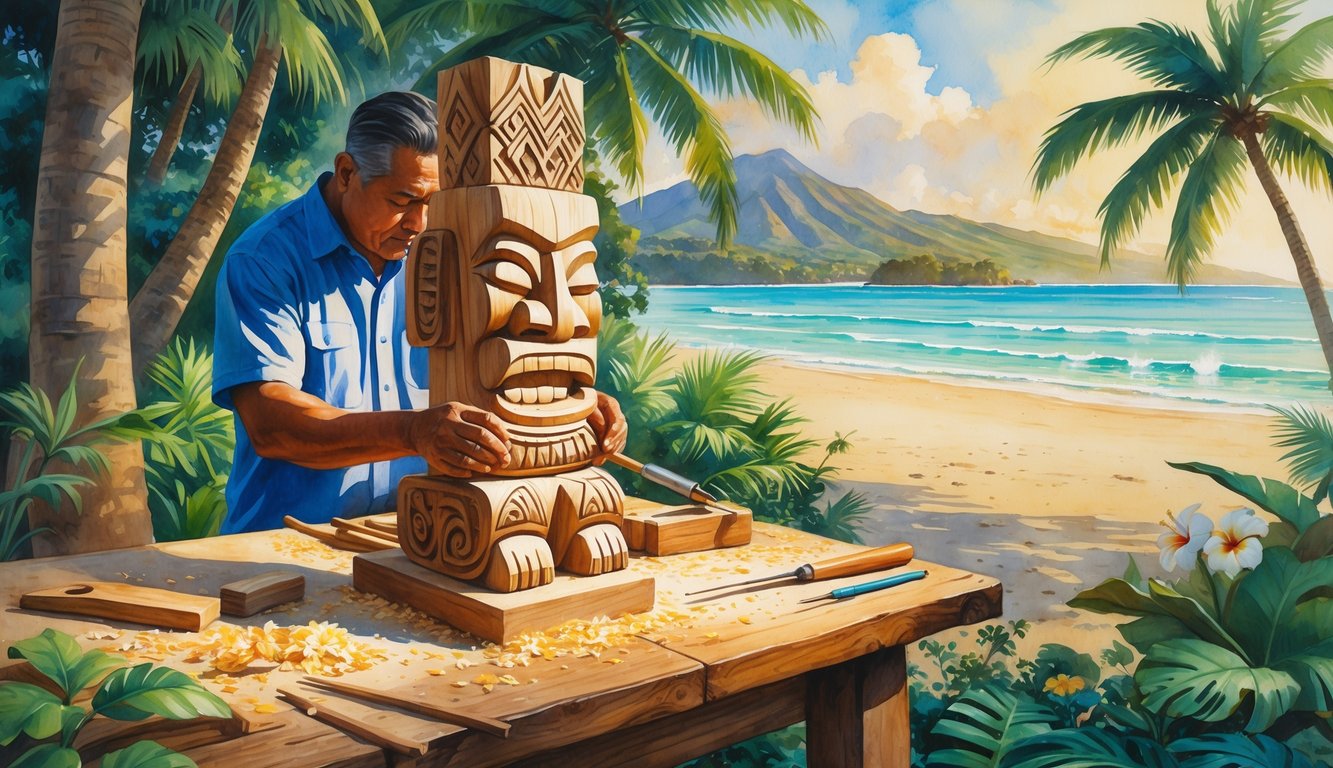
Learning Hawaiian wood carving means more than just using tools. It connects me to culture, family, and the land.
Through hands-on teaching, time with elders, and sharing knowledge, this art form stays alive.
Workshops and Classes
I find that workshops and classes are a great way to get started with Hawaiian wood carving. They often teach me basics like how to safely use carving knives and chisels.
Experienced carvers design most classes and share both technique and cultural meaning. Many workshops let me practice on traditional woods, such as koa and milo.
Using these woods helps me understand how each type has its own feel and history. Some classes include lessons about the stories or gods behind certain tiki carvings.
Learning in a group helps me see how every carver creates something unique. Carving together brings out different ideas and makes it easy for beginners to ask questions.
I appreciate hands-on practice because I leave every class with a finished piece and more confidence.
Key benefits I experience in workshops and classes:
- Step-by-step demonstrations
- Use of local Hawaiian woods
- Support from skilled teachers
- Cultural background for each project
To find these classes, I check local art centers, cultural festivals, or community colleges. Many schools and tours offer sessions for visitors interested in the craft.
Reading about workshops and classes in Hawaii also helps me plan my learning.
Community Involvement
Being active in my community helps me grow as a wood carver. Carving isn’t just about making art; it’s about giving back and learning together.
Many carvers, including myself, join community groups or attend carving events in parks and local markets. At these gatherings, teachers and elders often share stories, songs, and rituals tied to the pieces we carve.
I’ve learned that carving sessions can be group activities where everyone helps each other. These events are also a way for different generations to connect.
Volunteering at festivals or teaching at fairs gives me another way to get involved. By carving in public spaces or donating works to charities, I help keep the tradition strong.
Seeing others enjoy and learn from my carving motivates me to keep practicing. If I want to see community carving in action, I attend events like the Hawaiian Cultural Festival.
Here, beginners and experts work side by side, showing that this tradition belongs to everyone. More about how modern carvers keep the culture alive is shared in contemporary carving communities.
Passing Down the Tradition
Passing down wood carving is about more than teaching skills. It’s how families and teachers share values, stories, and pride in Hawaiian culture.
I am grateful when older carvers take the time to teach me in person. In my experience, elders give advice not found in books.
They explain why each step matters and share personal stories about family traditions. Many of their lessons come from watching, listening, and practicing side by side.
Families often save certain tools, patterns, or types of wood for special heirs. This gives me a sense of being trusted with something important.
When I carve with children in my family, I try to teach them both the techniques and the reasons behind each design. These traditions continue because each generation adds its own touch.
The individuality of each piece reflects the carver and their story. Carving becomes a family legacy that is always growing, as described in the history and meaning of wood carving in Hawaii.
Sustainability and the Future
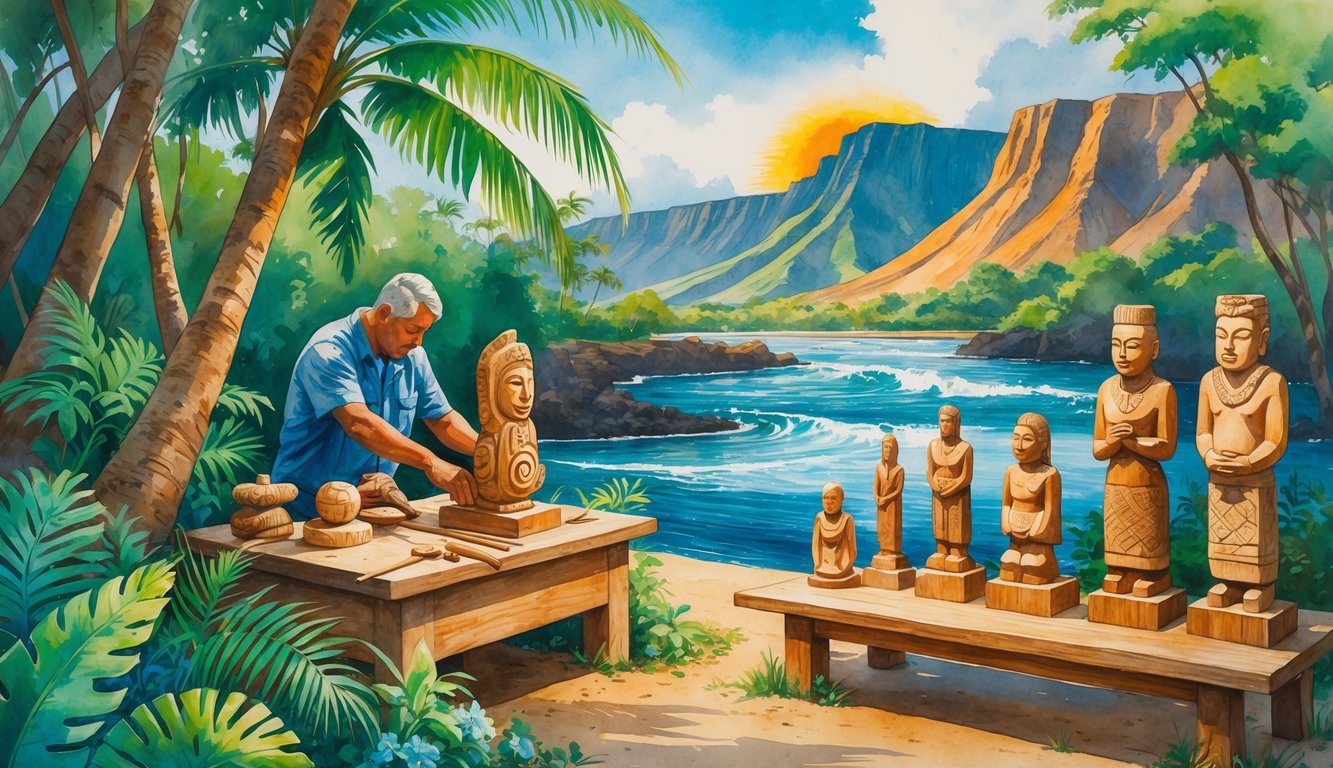
I see that Hawaiian wood carving faces both opportunities and challenges as people work to protect the environment and keep cultural practices alive. Preserving forests, making smart choices about materials, and meeting new problems with creative solutions are all important.
Reforestation Efforts
Reforestation supports the future of Hawaiian wood carving. Some groups in Hawaii now plant native trees, like koa and milo, to replace those lost or cut down long ago.
These trees grow slowly, so planning for the future is necessary. Organizations bring together communities for tree-planting events and offer educational programs.
These programs help me understand which native species are best for carving and which are threatened. Local artists often support these efforts, not just to have material, but to keep forests healthy for future generations.
Replanting takes commitment and patience, because newly planted trees may take decades to mature. I notice more workshops and programs that teach about forest care, such as the “Carving Out Our Future” series, which focus on stewardship as well as art.
Ethical Wood Sourcing
Choosing the right wood is one of the biggest decisions for any carver. I pay attention to where my wood comes from and seek out suppliers who harvest responsibly.
Ethical wood sourcing means using wood only from trees that can be replaced, are not endangered, or have already fallen due to storms or age. Some carvers collect wood from wind-fallen branches or from trees removed for safety reasons.
This helps prevent waste and avoids cutting living, healthy trees. I ask about certification or sourcing whenever I buy wood to make sure it was harvested sustainably.
Certain woods used in carving, such as rare Hawaiian koa, now face regulation. By following best practices, carvers and artists help protect these resources.
It also sets a positive example for others, showing that tradition and responsibility can go together.
Challenges Ahead
Keeping Hawaiian wood carving sustainable isn’t easy. Deforestation, invasive species, and land development threaten native trees.
As some woods become rarer, carvers try new materials, recycle, or use smaller pieces. Climate change also stresses forests by changing rainfall and spreading pests.
Traditional species struggle to survive. More young carvers now join forest stewardship and sustainability programs.
Artists, landowners, businesses, and the community need to work together. Education and new techniques can help Hawaiian wood carving continue in a responsible way.




